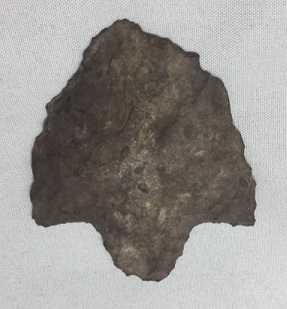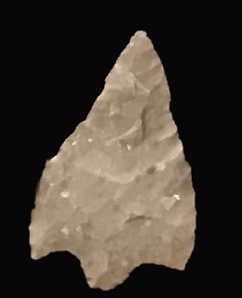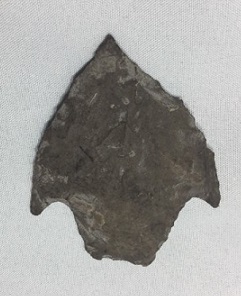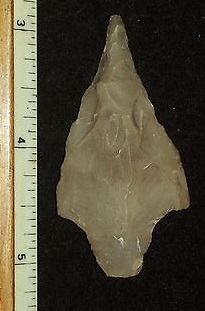Outline is Representative of Size and Shape:
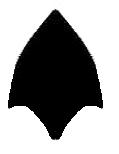
Name Details:
Identified By: Dee Ann Suhm, Alex D. Krieger, and Edward B. Jelks
Named For:
Date Identified: 1954
Type Site:
Identified By: Dee Ann Suhm, Alex D. Krieger, and Edward B. Jelks
Named For:
Date Identified: 1954
Type Site:
Point Validity:
Valid type
Suhm was an eminent Texas Anthropologist who, among many distinguished positions, served as Director of Texas Archaeological Research Laboratory. Krieger was a renowned Anthropologist who spent most of his career in Texas cataloging projectile points and pottery in Texas before moving on to the University of Washington. Jelks was a distinguished Anthropologist who’s work furthered the understanding of Texas archeology and was a founding force for the Society of Historical Archeology. This point was named in a professional publication and has many professional references. This is a valid type.
Suhm was an eminent Texas Anthropologist who, among many distinguished positions, served as Director of Texas Archaeological Research Laboratory. Krieger was a renowned Anthropologist who spent most of his career in Texas cataloging projectile points and pottery in Texas before moving on to the University of Washington. Jelks was a distinguished Anthropologist who’s work furthered the understanding of Texas archeology and was a founding force for the Society of Historical Archeology. This point was named in a professional publication and has many professional references. This is a valid type.
Almagre Contracting Stem
Cluster: Description of Physical Characteristics and Flaking Pattern:
This is a broad thick medium to large triangular contracting stem point with an elliptical cross section. The blade is broad with primarily excurvate edges, but may range from an inward recurvate to straight. The blade is commonly asymmetrical with one edge being straighter than the other edge. The shoulders may vary from having an upward angle to being barbed. The stem may range from contracting to only slightly contracting with a is contracting. The base is ranges from straight to slightly convex or concave with rounded basal corners. This point is commonly crudely made using using a few percussion flakes leaving scars on the faces pointing towards the center of the point. The point is finished with will controlled percussion flaking or pressure flaking leaving random flaking pattern.
Size Measurements:
Length - 47 to 100 mm (average 59 to 80 mm), Stem Length - 3 to 20 mm (average 8 to 12 mm) Width - 30 to 50 mm (average 36 mm), Stem Width - 13 to 30 mm (average 20 mm), Thickness - 5 to 15 mm (average 6 mm), (Suhm and Krieger, 1954, MacNeish, 1967)
Length - 47 to 100 mm (average 59 to 80 mm), Stem Length - 3 to 20 mm (average 8 to 12 mm) Width - 30 to 50 mm (average 36 mm), Stem Width - 13 to 30 mm (average 20 mm), Thickness - 5 to 15 mm (average 6 mm), (Suhm and Krieger, 1954, MacNeish, 1967)
Commonly Utilized Material:
Additional Comments:
It has been suggested that these may be preforms for such types as Gary and Langtry point (Turner and Hester, 1985). However, it has been noted by Suhm and Krieger (1954) that each of these types have their own distinct distribution pattern.
This point is similar to the Gary point, but is generally cruder than the Gary point.
It has been suggested that these may be preforms for such types as Gary and Langtry point (Turner and Hester, 1985). However, it has been noted by Suhm and Krieger (1954) that each of these types have their own distinct distribution pattern.
This point is similar to the Gary point, but is generally cruder than the Gary point.
Distribution: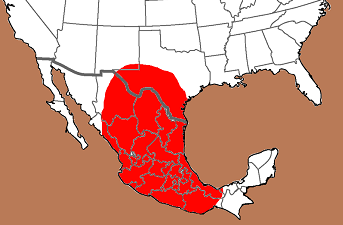

Distribution Comments:
This point is primarily found in the lower Pecos region and into southern Texas and northeastern Mexico. This point has been reported throughout southern Tamaulipas, Chipapas, Puebla, Hidalgo, Querertaro, the Valley of Mexico, Tehuacan Valley, Cueva de la Nopalera, Hildago, and western Mexico.
This point is primarily found in the lower Pecos region and into southern Texas and northeastern Mexico. This point has been reported throughout southern Tamaulipas, Chipapas, Puebla, Hidalgo, Querertaro, the Valley of Mexico, Tehuacan Valley, Cueva de la Nopalera, Hildago, and western Mexico.
Age / Periods:
Date: 5,000 - 4,000 B.P.
Cultural Period: Middle Archaic
Glacial Period: Middle Holocene
Culture:
Date: 5,000 - 4,000 B.P.
Cultural Period: Middle Archaic
Glacial Period: Middle Holocene
Culture:
Age Details:
Other points in this cluster / Related / Associated Points:

